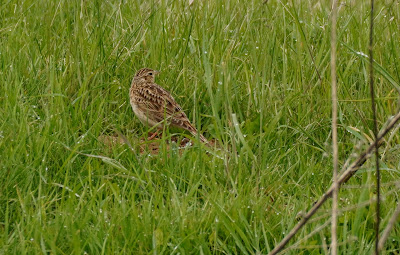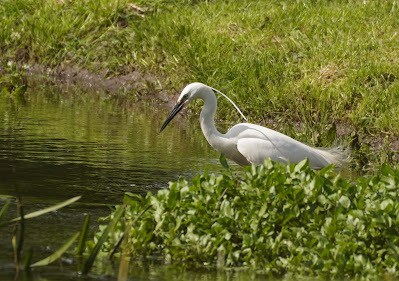I visited a good proportion of the estate this weekend. I started at the Doghouse practice ground on Saturday. I was pleased to see that the Skylarks were still around and look to be nesting. There were a lot of these Garden Chafer beatles on the grass. They are generally unpopular with the greenkeepers as the birds dig up the fairways looking for their grubs along with those of their larger cousin the Cock Chafter.
 |
| Garden Chafer Phyllopertha horticola [Doghouse practice ground] |
This Whitethroat was one of many singing around the estate - in the far corner of the practice area.
 |
| Whitethroat [Doghouse practice ground] |
Whilst watching the Whitethroat, I briefly saw a Common Lizard in the long grass, the first that I have seen at Frilford, but it was too quick for me to photograph. Fortunately I came across another today basking on a tree stump to the right of the 15th on the Red.
 |
| Common Lizard [15th Red] |
In the morning the front nine of the Blue was very quiet, so I waited for one of the Kingfishers by the 2nd Blue. This pale female Mallard came along and was very tame.
 |
| Mallard [2nd Blue] |
The Kingfishers made several visits, regularly catching fish in the stream and gave some nice views sitting on one of the yellow posts.
 |
| Kingfisher [2nd Blue] |
In the afternoon I visited the Tubney range. This Muntjac was enjoying the long grass.
 |
| Muntjac [Tubney range] |
I also explored the waste area next to the reservoir and came across three new plants for the Frilford list. Henbit Dead-nettle is rather inconspicuous and very similar to the Red Dead-nettle but is a little larger and has less nettle-like leaves.
 |
| Henbit Dead-nettle Lamium amplexicaule [Reservoir] |
Marsh Spurge is a garden escape. Its large size and bright yellow bracts make it more conspicuous.
 |
| Marsh Spurge Euphorbia palustris [Reservoir] |
Field Pennywort has distinctive seed-heads that resemble pennies.
 |
| Field Penny-cress Thlaspi arvense [Reservoir] |






















